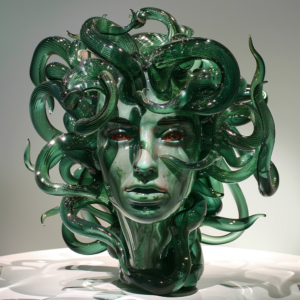Glass sculpting, with its captivating ability to transform light and form, boasts a rich and fascinating history. From its humble beginnings to its contemporary expressions, this art form has journeyed through millennia, reflecting the artistic and technological advancements of each era. Let’s embark on a captivating exploration, delving into the evolution of glass sculpting across time.
Early Beginnings: Unveiling the Ancient Legacy
The exact origins of glass sculpting remain shrouded in mystery, with archaeological evidence suggesting its practice as early as the 1st millennium BCE in Mesopotamia. These early pieces were likely small and functional, often used for religious purposes or decorative elements. The invention of the blowpipe in the 1st century BCE marked a significant turning point. This tool allowed for greater control over molten glass, enabling the creation of more intricate shapes and laying the foundation for the artistic potential of glass sculpting.
The Glory of Ancient Civilizations
Ancient civilizations around the world embraced glass sculpting, incorporating it into their artistic and cultural traditions. The Egyptians used glass for amulets and jewelry, while the Romans developed a taste for intricate glassware, including vessels and decorative objects. The Hellenistic and Roman periods witnessed a flourishing of cameo glass, a technique that involved carving intricate designs into layered glass.
Medieval Europe: A Shift in Focus
During the Middle Ages in Europe, glass sculpting primarily served religious purposes. Glassmakers crafted stained glass windows for churches and cathedrals, transforming ordinary light into breathtaking displays of color and narrative. These magnificent windows not only illuminated the spaces but also served as a powerful storytelling medium for religious teachings.
The Renaissance and Beyond: A Time of Innovation
The Renaissance ushered in a renewed interest in classical art forms, including glass sculpting. Venetian glassmakers played a pivotal role in this revival, establishing Murano as a global center for glass production. Their mastery of color and technique led to the creation of stunning sculptures and decorative objects, renowned for their intricate details and vibrant hues.
The Industrial Revolution and Modern Transformations
The Industrial Revolution brought about significant advancements in glass production techniques. Mass production methods lowered the cost of glass, making it more accessible to a wider audience. This period also saw the emergence of Art Nouveau and Art Deco movements, which embraced glass as a key decorative element. Sculptors experimented with new forms and incorporated glass into furniture and architectural designs.
Contemporary Expressions: Pushing the Boundaries
Today, glass sculpting continues to evolve, pushing the boundaries of creativity and technical expertise. Modern glass sculptors utilize a wide range of techniques, including glassblowing, casting, fusing, and kiln forming. They experiment with scale, incorporating glass into large-scale installations that interact with their surroundings. The focus on conceptual art has also opened doors for sculptors to explore themes of social commentary, environmental awareness, and personal expression through their glass works.
Conclusion: A Legacy of Innovation and Beauty
The history of glass sculpting is a testament to human ingenuity and artistic exploration. From its humble beginnings to its contemporary expressions, this art form has captivated audiences for centuries. The ever-evolving techniques and artistic visions ensure that glass sculpting continues to be a vibrant and dynamic art form, promising to surprise and inspire generations to come.



